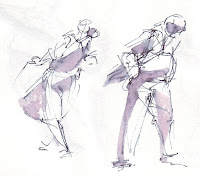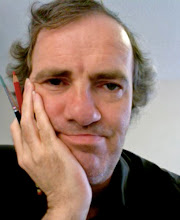Having worked myself twice through the bulk of 'The Natural Way to Draw', independently as well as supported by a variety of teachers, I dare say I am entitled to phrase my opinion on this workbook. Yes, the experience was Spartan, and, no, I do not believe it was worth the time and effort. Having spent four years at Max the Mutt, drawing from the model about eight hours a week, sketching on the streets of Toronto at least half an hour daily, I can only admit my drawing skills are basic.
In a nutshell, I believe the problem with Nicolaides is that he was an academic, as opposed to an artist. The art of his hand that has survived the twentieth century lacks the solid observational drawing skills I expect to see from an experienced teacher. It is possible that proof of his draftsmanship is securely locked away from the eye of the aspiring student, but for now I believe his work satisfies the qualification of being 'artsy-fartsy'. Kimon Nicolaides talked the talk; he could not walk the walk.
Of the few things I do agree with, the most pregant is that 'There is only one way to draw, and that is the perfectly natural way', and I do believe Nicolaides was sincerely trying to teach his understanding of this natural way. The same holds for teachers like Andrew Loomis, Michael Mattesi, and Glenn Vilppu, who all teach their view on the matter, each striking chords the others miss. In addition, their teaching job is severely complicated by the fact that students are unique, and a good teacher acknowledges this diversity. This is exactly where Max the Mutt fails, trying to cram its students in the founder's ragged old corset.
What has made Nicolaides' approach so popular over the past one-hundred years is its Spartan approach. It is easy to fall in the same trap as the disciples of Malcolm Gladwell who believe that 10,000 hours of practice are sufficient to achieving world-class expertise in a field of choice, ignoring the original observation that the "10,000 hours rule" expresses a necessary condition. Just as running for 42 kilometers in the wrong direction does not make one a marathon finalist, completing The Natural Way to Draw does not make one an artist, although it is quite an accomplishment!
Another factor that contributes to the book's popularity is that it provides teachers a detailed curriculum. There is no more thinking about telling students what to do, how to and when to do it: work for three hours according to Schedule 13! Grading is a breeze: just score your students' efforts! Serious teachers will prefer to focus on students progress and skills, as opposed as their shutting up and doing as they are told, but for lazy teachers The Natural Way to Draw is a godsend.
Apart from Kimon Nicolaides being neither effective nor efficient, I believe his approach is not suited for the absolute beginner: I remember the fellow students who got the most out of it had already completed some form of art school, or at least had a solid grasp of the human figure. This is also acknowledged by accomplished illustrator and former Max the Mutt teacher Richard Pace in The Evils of Kimon Nicolaides. I believe there is wisdom in Andrew Loomis' Figure Drawing for all it's worth, where he first introduces human proportions and then presents his students with a simplified manikin as a starting point.
I am looking forward to the opportunity, one Glorious Day, to discuss life drawing with Kimon Nicolaides. I am sure he will agree to include Loomis, Mattesi and Vilppu for a good art class where everything life drawing will come together. For now, in this time and space, I will conclude by paraphrasing the Dutch computer science pioneer E.W. Dijkstra: "Kimon Nicolaides considered harmful."
2 weeks ago



